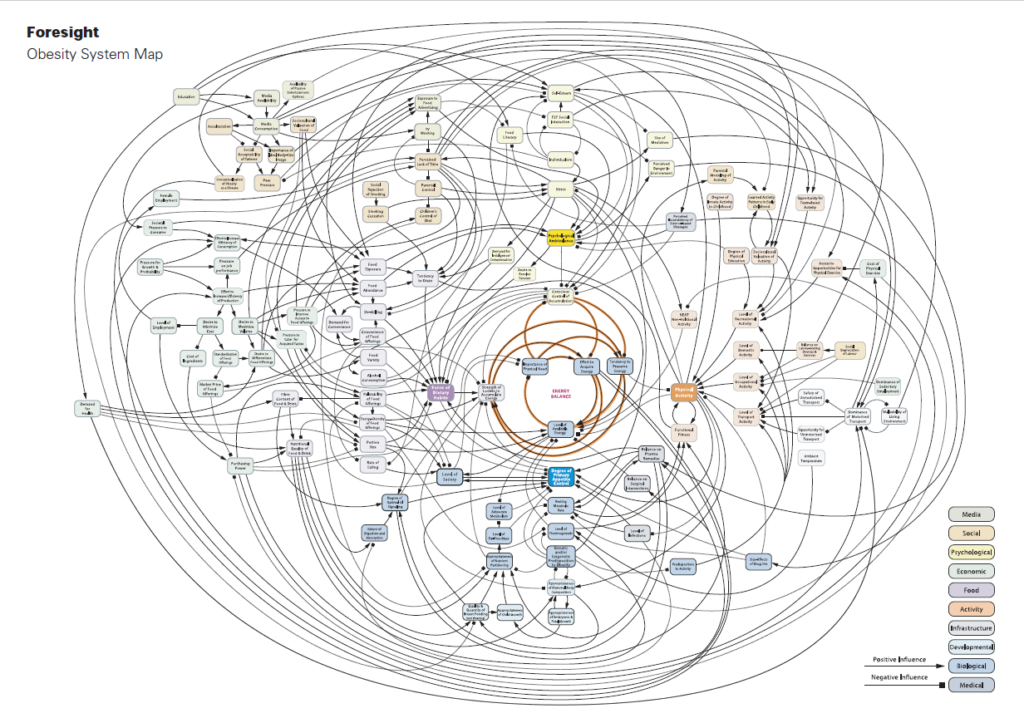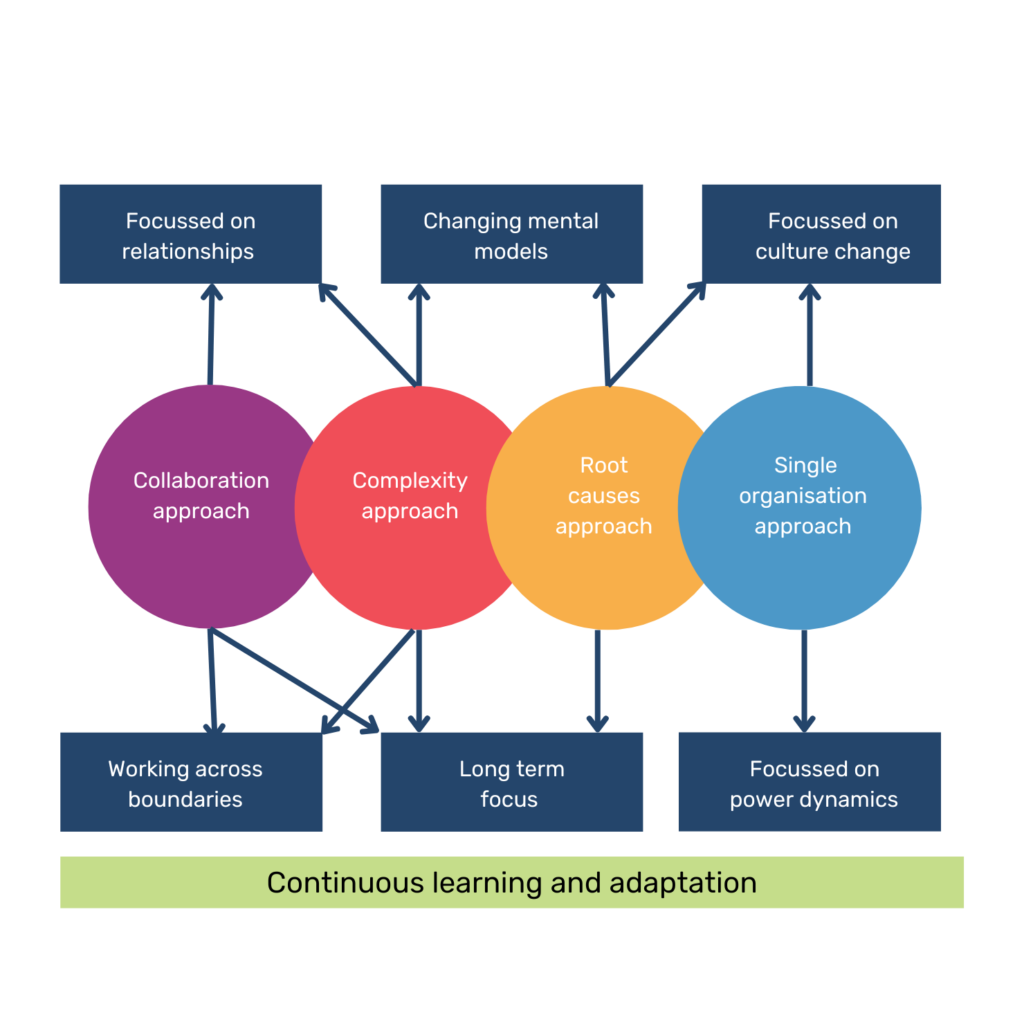Systems change: all things to all people?
Associate Director of Place and Systemic Change, Beth Stout describes four ways organisations and places can start to explore systems change.

I’ve always known that the concept of systems change is hard to describe, and consequently means different things to different people.
At best, systems change is a way of understanding and seeing the world differently, enabling us to see the interconnected and embedded nature of problems, and to use this context to think about how we make change. At worst, it can feel overly academic and exclusionary; too theoretical to be practical. Personally, I’ve been part of conversations that are so complex I’ve come away feeling thoroughly disempowered.
One of the reasons I joined the Renaisi team was because I like how their work on systems change is rooted in the very practical experience of our own teams and our partners, who are working to change local systems.
Now I’ve been part of the Renaisi team for a while, I have built on some of that learning with insight drawn from recent projects.
There isn’t one ‘right’ approach to systems change
We recently worked on a project exploring what it means to take a systems-change approach. We interviewed specialists in place-based change and systemic change across the UK and beyond. It quickly became clear that ‘taking a systems-change approach’ meant different things to different people and organisations.
It seemed that to engage with a concept like systems change at a practical level, organisations found it most helpful to have a starting point for their approach.
Throughout these conversations, we identified four approaches people tend to take to systems change. While those we spoke to had different roles, organisations, and types of expertise, taking one of these four approaches gave seemed to give them a solid starting point to better explore systemic change.
Four approaches to systems change

1. Collaboration
Collaboration is one of the most common starting points. To solve a problem that is bigger than any one organisation, partnerships are formed to explore systems change approaches together.
Key features include
- An understanding of the importance of the quality, depth and expansion of relationships.
- Collaborative decision making, a focus on shared strategies and mutually-owned outcomes.
- Increasingly strengthened relationships, across as much of the system as possible.
2. Complexity
People often think of complexity when they think about systems change. It can feel like a challenging starting point for systems work, as it requires us to be comfortable with a significant level of uncertainty and the knowledge that we can’t get to a single ‘right’ answer.
Complexity helps us to consider the multiple different facets of an issue, and to understand how decisions made in one part of the system can determine outcomes in another part of the system. It requires people to look at their world differently.
The starting point of a complexity approach could be helping people understand that they operate within a system, and showing them what that system looks like. This can help identify leverage points for making change.

Obesity System Map from .gov.uk
Key features of this approach are:
- To stop putting the world into siloes and assuming change happens in linear ways. We do this to make it easier to understand, but it can over-simplify issues and mean we don’t look at what’s really going on.
- Letting go of the tools we use to manage a linear approach to change.
- Recognising that while we can’t always control how change happens, we can keep learning and adapting to the context of the system we’re working within.
3. Root causes
A root causes approach focuses on changing the conditions that hold issues in place.
Starting with root causes means recognising the deeply embedded conditions that often drive the problems we seek to address. These embedded issues often include systemic racism, ‘spatial stigma[1]’ (stigma attached to a particular place and the people who live there), entrenched power dynamics, and discrimination on the basis of social class.
This approach recognises that without shifting the harmful root causes underlying the outcomes the system is creating, the problems themselves will continue to occur.
Key features of this approach are:
- Identifying and acknowledging harmful power dynamics, beliefs or narratives
- Exploring and designing for structural change – the structures within society that can often be structures of oppression
- Exploring cultural change within and across organisations – challenging how we work together and the power we each hold.
4.Single organisation
A single organisation approach focuses efforts on working with, and changing the behaviour of, a single major actor within the system.
Two framings of a single organisation approach emerged from this research:
- The first focused on changing an organisation that holds (or was perceived to hold) most of the power – money, resources, influence – in a place. There is merit in trying to understand and shift the structures inherent in organisations that hold significant power in a system, as this can have huge knock-on effects. It can be difficult to shift an organisation that is not your own, but we can work collaboratively with organisations to try to support this change.
- The other framing of a single organisation approach would be recognising the importance of starting with your own system. No single organisation will be showing up in a system in a way that demonstrates only systemic behaviours, or in a way that demonstrates all the behaviours they want to exhibit. All organisations will need to continuously grow and adapt, reflecting on their role within the system.
Key features of this approach are:
- It is based on the idea the efforts may be best focussed on the players with the most resources and power within a system.
- When applied to a group or organisation that the intervenor sits within, it is based on the idea that we may need to change ourselves before we can change others.
How to use these approaches to systems change
If you’re struggling to know where to start with systems change, picking an approach is a good starting point.
It can help you to wade through some of those unhelpful feelings of systems change being too difficult, too academic, or too exclusive.
Starting with any one approach can be a good route to exploring others. Like everything else relating to systems change, the approaches don’t exist in siloes. There are significant overlaps between these approaches particularly around some of the key features associated with systems change.

Understanding the connections between approaches can help you to think about the different elements of a systems approach.
For organisations that have started with a collaboration approach, their long-term focus may give them the time and space to begin to interrogate the root causes at the heart of the issues they’re working on.
For those taking a complexity approach, their focus on changing mental models around linearity and how we think about change, may lead to an interrogation of ourselves and where that thinking originated.
Renaisi can help
We believe, done well, systems change approaches can lead to equitable and sustainable change because they actively seek to understand and address harmful power imbalances or sources of injustice by including everybody who has a stake in an issue.
We’ve developed a language, frameworks and a series of case studies about places that are learning to change the system. Our aim is to learn more, alongside others, about what systems change looks like in practice.
These 4 approaches are our starting points. Over the next year, we’re going to be diving deeper into the question of what it takes to change a system. We’ll be talking more about this soon, and we hope you’ll join us.

- Want to find out more?
- Contact Beth Stout on:
- 020 7033 2651
- b.stout@renaisi.com



